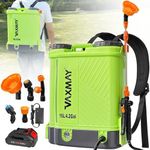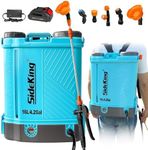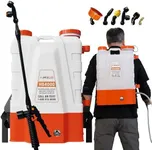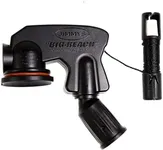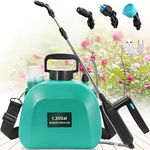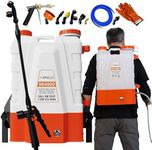Buying Guide for the Best Electric Backpack Sprayers
Choosing the right electric backpack sprayer can make a significant difference in the efficiency and ease of your spraying tasks. Whether you are a gardener, landscaper, or farmer, understanding the key specifications will help you select a model that best fits your needs. Here are the essential specs to consider when picking an electric backpack sprayer.Tank CapacityTank capacity refers to the amount of liquid the sprayer can hold. This is important because it determines how long you can spray without needing to refill. Tank capacities typically range from 2 to 6 gallons. Smaller tanks (2-3 gallons) are lighter and easier to carry, making them suitable for small gardens or yards. Larger tanks (4-6 gallons) are heavier but allow for longer spraying sessions, ideal for larger areas or professional use. Choose a tank size based on the size of the area you need to cover and your ability to carry the weight.
Battery LifeBattery life indicates how long the sprayer can operate on a single charge. This is crucial for ensuring you can complete your tasks without frequent recharging. Battery life can range from 2 to 8 hours. For small to medium-sized areas, a battery life of 2-4 hours may be sufficient. For larger areas or professional use, look for a sprayer with a longer battery life (5-8 hours). Consider how long your typical spraying sessions last and choose a model that can meet those needs without interruption.
Pump TypeThe pump type affects the pressure and flow rate of the sprayer. Common types include diaphragm pumps and piston pumps. Diaphragm pumps are more durable and can handle a variety of chemicals, making them suitable for professional use. Piston pumps provide higher pressure and are ideal for tasks requiring fine misting. If you need versatility and durability, a diaphragm pump is a good choice. If you need high pressure for specific applications, consider a piston pump.
Spray PressureSpray pressure, measured in pounds per square inch (PSI), determines the force at which the liquid is sprayed. Higher pressure allows for better coverage and penetration. Typical pressure ranges from 40 to 150 PSI. For general gardening and light-duty tasks, 40-70 PSI is usually sufficient. For more demanding tasks like tree spraying or reaching high areas, 70-150 PSI may be necessary. Assess the type of spraying you will be doing and choose a pressure range that matches your needs.
WeightThe weight of the sprayer, both empty and full, is important for comfort and ease of use. A lighter sprayer is easier to carry, especially for extended periods. However, larger tanks and more powerful batteries will add to the weight. Consider your physical strength and the duration of your spraying tasks. If you need to spray for long periods or have limited strength, opt for a lighter model. If you can handle more weight and need a larger capacity, a heavier model may be suitable.
Nozzle TypesNozzle types determine the spray pattern and coverage. Different nozzles are designed for various tasks, such as wide-angle spraying, fine misting, or targeted spraying. Having multiple nozzle options can increase the versatility of your sprayer. For general use, a sprayer with adjustable or interchangeable nozzles is ideal. Consider the types of spraying tasks you will perform and ensure the sprayer comes with the appropriate nozzles for those tasks.
Durability and Build QualityDurability and build quality are important for ensuring the sprayer can withstand regular use and exposure to chemicals. Look for models made from high-quality materials like stainless steel, heavy-duty plastic, or corrosion-resistant components. A well-built sprayer will last longer and require less maintenance. If you plan to use the sprayer frequently or for professional purposes, invest in a model known for its durability and robust construction.
